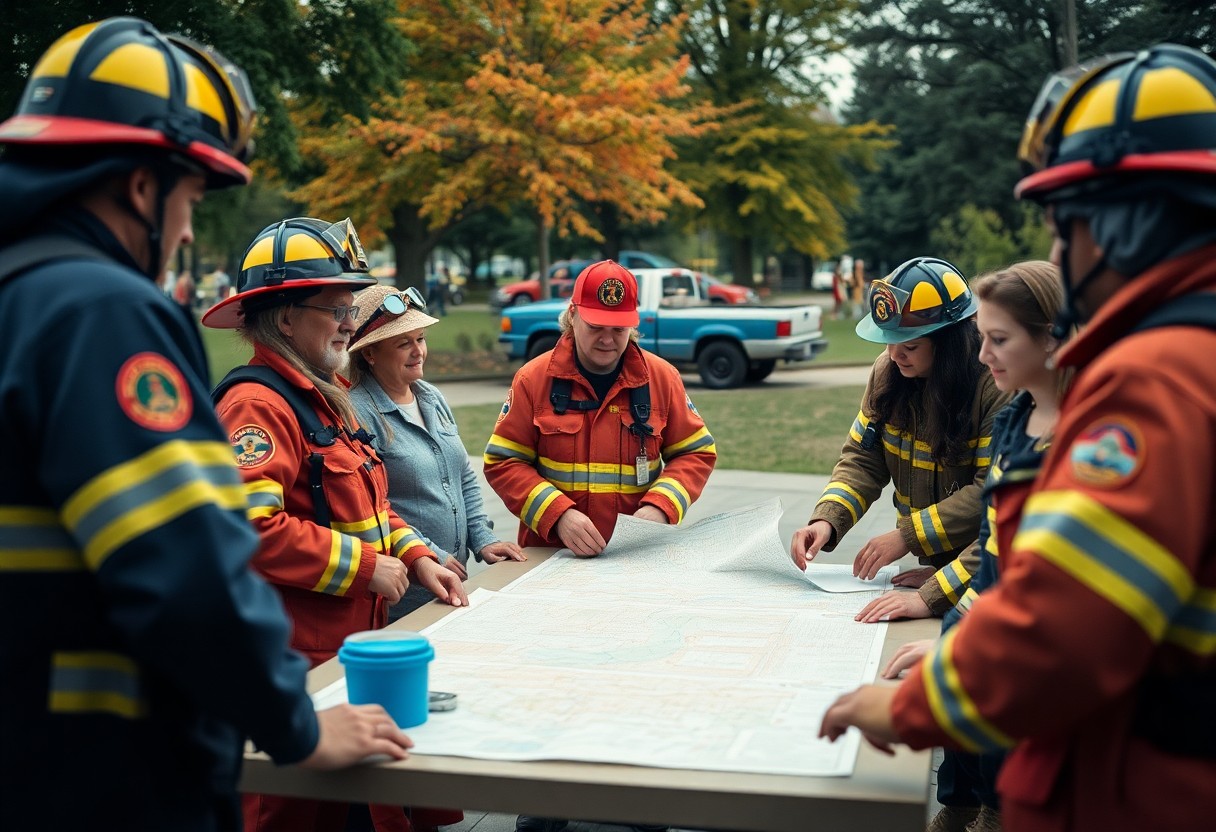Community engagement during the summer months is important for enhancing your volunteer fire department’s emergency preparedness. As temperatures rise, so does the risk of wildfires and various emergencies, demanding your proactive approach in both planning and training. In this post, we will guide you through effective strategies to ensure your department is ready for any situation. Equip yourself and your team with the knowledge and tools necessary to protect your community from potential threats this season.
Understanding Community Emergency Preparedness
A robust community emergency preparedness plan is vital for effectively responding to natural and man-made disasters. By assessing potential hazards, engaging with local resources, and fostering community involvement, you can enhance your community’s resilience. Preparedness involves public education, resource allocation, and establishing communication channels to ensure a coordinated response when emergencies arise.
Key Factors Influencing Preparedness
For enhancing community emergency preparedness, consider these key factors:
- Local hazards and risks
- Available resources and training
- Community engagement and participation
- Regular drills and evaluations
The combination of these elements will significantly influence the effectiveness of your community’s preparedness efforts.
The Role of Volunteer Fire Departments
Volunteer fire departments play a vital role in fostering community emergency preparedness. You serve as a frontline resource in emergencies, ensuring rapid response and providing crucial services during crises. Your proactive engagement with the community builds trust, enhances awareness of local risks, and promotes preparedness education.
To maximize your impact, volunteer fire departments should actively participate in community outreach initiatives, offering training sessions and workshops on emergency response strategies. Building relationships with local organizations and schools is also key to spreading awareness about safety measures. Additionally, your presence during drills and public events emphasizes the importance of community collaboration and preparedness planning. Ultimately, by equipping community members with the right tools and knowledge, you significantly boost their ability to handle unexpected emergencies.
How to Assess Community Needs
Clearly, understanding the specific needs of your community is the first step towards effective emergency preparedness. By assessing potential hazards and vulnerabilities, you can tailor your response strategies to focus on mitigating risks and enhancing local resilience. This proactive approach not only prepares your department but also fosters a safer environment for all residents during the summer months.
Conducting Risk Assessments
With a thorough risk assessment, you can evaluate the various threats your community faces, such as natural disasters, fires, or health emergencies. Engage in data collection and analysis to identify high-risk areas and populations. Utilize this information to prioritize your resources and interventions, ensuring that your planning efforts address the most pressing needs of the community.
Engaging with the Community
The engagement process with your community is crucial to identify its unique needs effectively. By fostering open lines of communication with residents, you gain valuable insights and develop trust, which ultimately leads to improved preparedness. Involving community members in discussions and planning sessions harnesses their local knowledge, ensuring your strategies are relevant and effective.
A combination of outreach initiatives, such as community meetings, surveys, and social media engagements, can help uncover your residents’ needs. Be open to feedback and actively listen to concerns regarding potential threats. This collaboration fosters a sense of shared responsibility for emergency preparedness. Encourage volunteers, local organizations, and residents to contribute their ideas, as this can lead to innovative solutions tailored to your community’s specific challenges.
Proactive Tips for Emergency Planning
Assuming your community is at risk for various emergencies, it’s vital to develop a proactive approach to emergency planning. Here are some vital actions you can implement:
- Conduct a thorough risk assessment of your area.
- Engage with local agencies to enhance cooperation.
- Organize community workshops on disaster preparedness.
- Identify key resources and create a resource inventory.
- Schedule regular emergency drills to ensure readiness.
Perceiving these strategies as a foundation will significantly enhance your community’s safety during emergencies.
Developing an Effective Emergency Plan
One of the first steps in ensuring community resilience is to develop an effective emergency plan. Your plan should clearly outline roles, responsibilities, and protocols for responders and residents alike. Engaging local stakeholders can help identify specific needs and resources available in your area.
Creating Communication Strategies
Some of the most effective emergency responses stem from sound communication strategies. Establishing clear and multi-channel communication methods helps ensure that everyone stays informed and prepared.
It’s important to create systems that can reach your entire community quickly. Utilize social media, local news outlets, and community bulletins to disseminate information. In addition, consider implementing a text alert system for real-time updates during emergencies. This allows you to communicate critical information swiftly, which can be especially significant in times of crisis. Clear and prompt communication can drastically reduce confusion and empower residents to take protective actions when necessary.
Training and Resources
Unlike many organizations, volunteer fire departments must prioritize ongoing training and resource allocation to enhance community emergency preparedness. By investing in comprehensive training programs and leveraging local resources, you can effectively equip your team to respond swiftly and effectively this summer.
Essential Training for Volunteers
You play a vital role in ensuring that all volunteers receive important training. This includes basic firefighting techniques, first aid, and emergency response protocols. Regular drills and simulations will help to sharpen your skills and bolster confidence, enabling you to act decisively during emergencies.
Utilizing Community Resources
There’s a wealth of community resources available that can enhance your training and preparedness efforts. By partnering with local organizations, you can tap into experienced personnel and specialized equipment, creating a stronger support network for your volunteer team.
For instance, collaborating with local schools and emergency management agencies can provide valuable resources such as venues for drills, training materials, and experienced trainers. Establishing connections with local businesses may also yield sponsorships or donations of supplies and gear. These partnerships not only enhance your operational capabilities but also foster a sense of community involvement, making your volunteer fire department a respected pillar of your neighborhood’s emergency preparedness efforts.
Tips for Summer-Specific Emergencies
Your volunteer fire department can enhance community safety by prioritizing awareness and readiness for unique summer emergencies. Consider these proactive measures:
- Educate the community on wildfire prevention techniques.
- Encourage checks on severe weather alerts and updates.
- Organize training sessions for emergency response during summer storms.
- Engage local businesses in preparedness plans.
The combination of vigilance and action can significantly reduce risks this summer.
Preparing for Wildfires
The summer season poses a higher risk for wildfires, necessitating preparation and community education. You should promote fire safety measures, encourage regular brush clearing, and ensure proper equipment is accessible for your team. Consider disseminating information on creating firebreaks and maintaining defensible space around homes.
Addressing Severe Weather Preparedness
Even as summer brings sunny days, severe weather can strike unexpectedly. You need to inform your community about the importance of having emergency kits, knowing evacuation routes, and having communication plans for severe storms. Engaging local media to disseminate warning messages can amplify your reach.
Another vital aspect of severe weather preparedness is to conduct regular drills that involve community members, ensuring that everyone knows what to do during storms. This proactive approach builds community resilience, reduces panic, and enhances the effectiveness of your emergency response plan. Use this opportunity to emphasize the importance of staying informed through local weather updates and alerts, which can save lives and property in challenging times.
Building Partnerships and Support
For volunteer fire departments, building strong partnerships within your community is imperative for effective emergency preparedness this summer. By working with local businesses, organizations, and community leaders, you can leverage shared resources, enhance communication, and create a unified approach to disaster response and recovery. Establishing these connections not only helps in boosting local support but also fosters a culture of resilience within the community.
Collaborating with Local Organizations
Some organizations, like nonprofits and schools, can be valuable allies in your emergency preparedness efforts. By collaborating with them, you can pool resources, share knowledge, and develop training programs that cater to the unique needs of your community. This synergy will allow you to address vulnerabilities more effectively and enhance the overall readiness of your area.
Engaging Local Government and Agencies
Clearly, engaging with your local government and relevant agencies is key to a successful emergency preparedness strategy. Establishing communication channels with these entities will optimize coordination and resource allocation during emergencies. Participate in planning sessions, share your department’s capabilities, and advocate for community needs to ensure the safety and well-being of all residents.
Collaborating with local government agencies involves actively participating in community planning initiatives and emergency response drills. By doing so, you strengthen your relationships and enhance your department’s visibility. You can also gain valuable insights into local risks and explore potential funding opportunities for training, equipment, and resources. This collaboration is vital to developing a comprehensive emergency preparedness plan, allowing you to address specific vulnerabilities more effectively. Your efforts to foster these relationships will ultimately ensure a more cohesive, efficient, and prepared community during emergencies.
Summing up
Conclusively, you can enhance your community’s emergency preparedness this summer by implementing proactive strategies within your volunteer fire department. Engaging in regular training sessions, conducting community drills, and promoting awareness campaigns will empower your team and neighbors alike. By fostering strong partnerships with local organizations and establishing efficient communication channels, you’ll ensure that your community is better equipped to handle emergencies. Taking these steps will not only improve safety but also build resilience, allowing you to respond effectively when it matters most.
FAQ
Q: What are some effective ways volunteer fire departments can engage with their local communities for emergency preparedness this summer?
A: Engaging the community can be achieved through various approaches such as hosting workshops that educate citizens on fire safety and emergency response techniques. Organizing community drills allows residents to experience firsthand how they can act in emergencies. Furthermore, utilizing social media platforms to share safety tips, upcoming events, and important announcements helps keep the community informed and involved.
Q: How can volunteer fire departments assess and improve their resource availability for emergencies during the summer months?
A: Assessing resources can be done by conducting regular inventory checks of equipment and supplies. Volunteer fire departments should create a checklist of necessary items such as personal protective equipment, firefighting gear, and communication tools. Furthermore, reaching out to local businesses and civic groups for sponsorship or donations can bolster available resources. Continuous training and skills assessment of volunteers also ensure that the department can operate effectively in emergencies.
Q: What role do partnerships play in enhancing community emergency preparedness for volunteer fire departments?
A: Partnerships with local organizations, businesses, and government agencies can significantly enhance emergency preparedness. Collaborative initiatives such as joint training sessions, community outreach programs, and resource sharing help establish a more effective emergency response network. Building relationships with local health services, schools, and community groups can also foster a supportive environment where everyone understands their role in emergency preparedness efforts, contributing to overall safety and resilience in the community.



